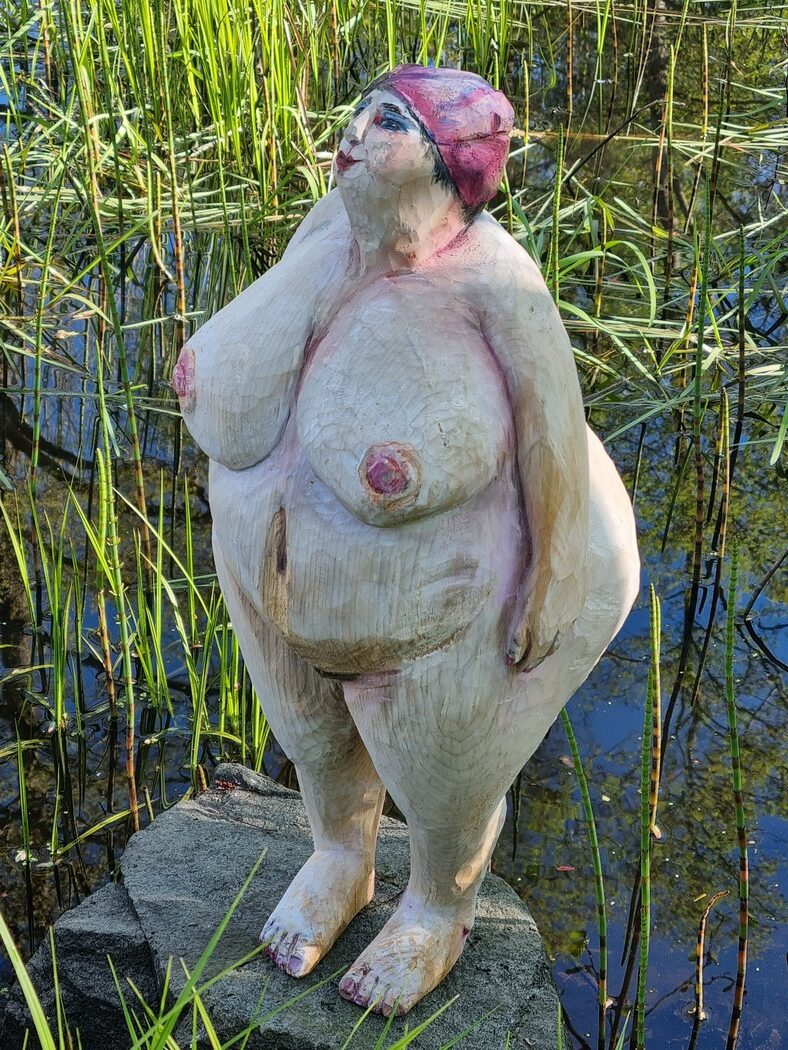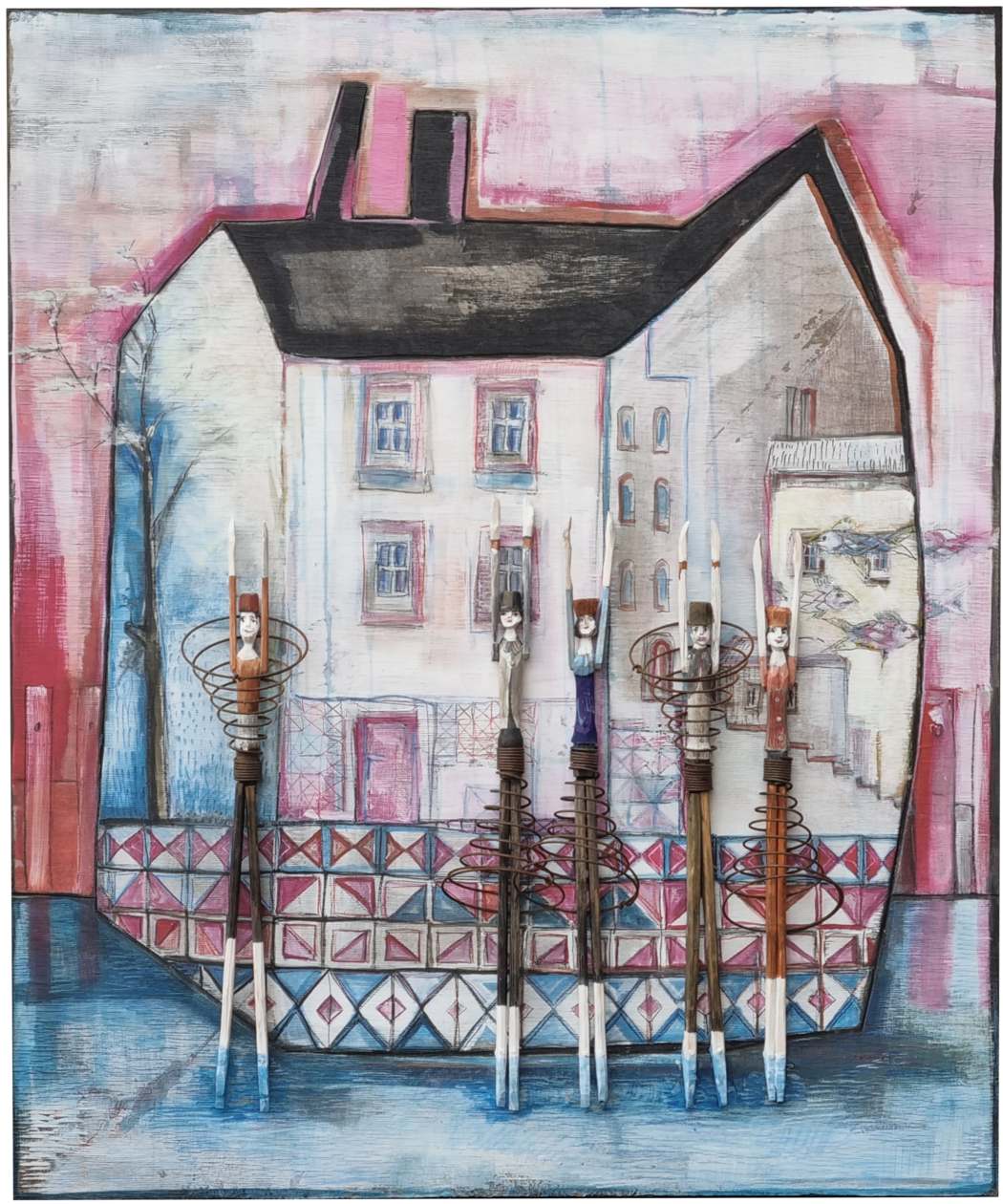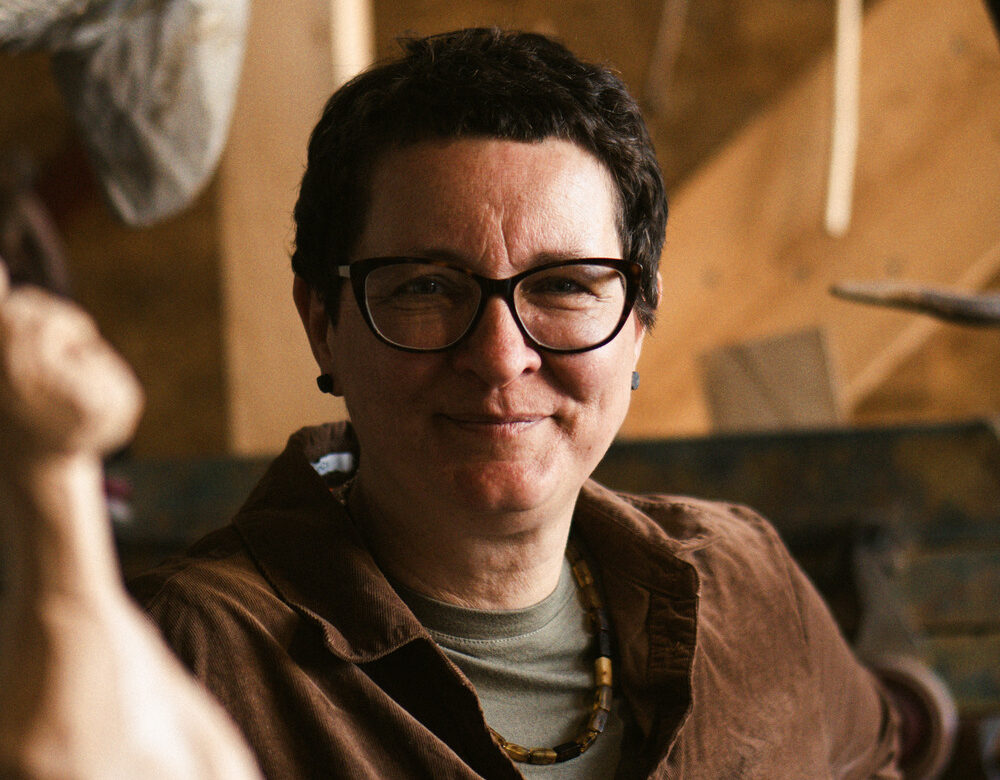Anja Werner
Year of birth: 1971.
Where do you live: Plauen, Saxony, Germany.
Your education: Construction and furniture carpentry, studied applied arts/wood design with Prof. Brockhage and Prof. Kaden at the Schneeberg Academy of Fine Arts, studied with the Makonde people in Tanzania, and received a diploma.
Describe your art in three words: Narrative, colorful, and humorous.
Your discipline: Wood carving, painting, collage, and graphic design.
Website | Instagram
How did you decide to pursue a career in the arts, and what inspired you to specialize in wood and sculpture?
My path into art began very early, inspired by my grandfather, who returned from World War II blind and began to sculpt animals from clay—powerful figures like bulls, gorillas, or toucans. I grew up in East Germany, and he lived in the West—unreachable to me, but his works stood in our home. As a child, I believed: this grandfather could perform magic.
Around the age of ten, I began drawing and carving myself, using a pocketknife to uncover figures from bark and wood scraps—beings hidden in the material. Later, I spent many years apprenticing with a wood sculptor during school. Wood was never a conscious choice for me—it was simply always there, my material, just as clay was his. I trained as a carpenter with the goal of studying wood design afterward. It always felt right. I never had a Plan B—the path of art was mine from the beginning.
You’ve had the opportunity to study and work in different cultural settings, such as with the Makonde carvers in Tanzania. How have these experiences influenced your creative process and artistic vision?
During my design studies, I traveled to the Makonde carvers in Tanzania—with nothing but a backpack and my carving knife. Very quickly, I realized that I wanted to work in a freer, more narrative, and artistic way with wood than my design studies allowed. Fortunately, I had a professor who supported me and guided me into a new world of creation. Among the Makonde, I encountered a deep appreciation for handmade, lovingly crafted everyday objects—not industrially optimized design products, but one-of-a-kind pieces with emotional and cultural value for their owners. At the same time, I experienced a visual language that floated between reality and surrealism, between life and poetry. This artistic approach was a turning point for me: it meant freedom—because it made everything possible.
 Anja Werner | Paloma, Täubchen | 2025
Anja Werner | Paloma, Täubchen | 2025
In your project statement, you emphasize freedom of expression and the exploration of boundaries. How do you feel your work pushes these boundaries, and can you share an example of a piece where this is especially evident?
I see boundaries as those created by upbringing, family background, societal norms, and political structures—contexts into which we are born without choosing them. As we grow, we come up against what we can endure, and we begin to question patterns, change behaviors, and shift perspectives. I continuously try to look at these inherited structures from new angles. The material wood helps me in this—it is willful and communicative and reveals things to me only through the act of making. I am particularly moved by the role and perception of women. These themes seduce and inspire me to reinterpret them through art. An example is my most recent piece: PALOMA—Spanish for “my little dove.” This figure is round, soft, voluminous, and confident. She does not conform to conventional ideals of female beauty, and yet she is exactly that: beautiful. Because she is content with herself. The wood shows traces of worms, some rot, and missing fibers—yet that is exactly what makes it beautiful.
Your sculptures often integrate human figures with natural elements like wood. How do you balance the organic nature of the material with the human form in your work?
I feel a profound connection between wood and the human being. Wood is alive, carries a story within, is willful, sometimes stubborn, but also generous and full of surprises. It gives me shapes, but it also takes them away when I ask too much. This is where its honesty lies.
The human figure is similarly multifaceted—soft and brittle, hard and vulnerable, full of strength and at the same time fragile. When I work with wood, I sense this kinship: two beings meeting, respecting, and shaping each other. Ideally, a sculpture emerges from this encounter that makes something internal visible—something that belongs neither to the wood nor to me alone, but arises between us.
 Anja Werner | Paloma, Täubchen | 2025
Anja Werner | Paloma, Täubchen | 2025
The idea of “exploration and discovery” seems central to your artistic practice. Can you share a moment in your career when such an exploration led to a breakthrough or a significant change in your work?
I’ve always felt like a seeker—and eventually a discoverer. I find great joy in small things, in connections and logics that may be well known to others but that I’ve worked to uncover for myself. I’m particularly fascinated by the logic of perspective drawing. It’s a deeply enriching moment when you can depict spatial complexity on a flat surface—when ideas become tangible. In my teaching, I’ve developed a guidebook that I’ll soon publish, which helps others access this way of thinking and drawing. There’s deep satisfaction in realizing that we, with our own hands, can visualize mental processes—something no digital tool can truly replicate.
What role does teaching and sharing knowledge with others play in your practice? How has this experience shaped your approach to creating art?
I was fortunate to have inspiring teachers who supported and guided me on my artistic path. I want to offer that same kind of support to young, aspiring artists—a chance to walk part of the way with them and offer encouragement. In every lesson, I learn something too. It’s a profound joy to enter into a respectful exchange, to celebrate others’ ideas, and to support their development. These encounters enrich my own artistic work and open up new perspectives again and again.
 Anja Werner | Zwitschern | 2025
Anja Werner | Zwitschern | 2025
You’ve exhibited your work internationally, including in Beijing and Miami. How do you approach displaying your sculptures and woodwork in different cultural contexts, and how does this influence the reception of your art?
For me, exhibitions are places of encounter and exchange between different cultural perspectives. That’s why I never tailor my exhibitions to a specific location—but to the story I want to tell. My perspective remains the same—whether in Beijing, New York, or Strasbourg. I believe this openness creates fertile ground for dialogue. Just as I bring my narrative with me, I hope to discover the artistic worlds of other cultures in return. It’s a mutual exchange that constantly enriches and evolves my work.


Leave a Reply